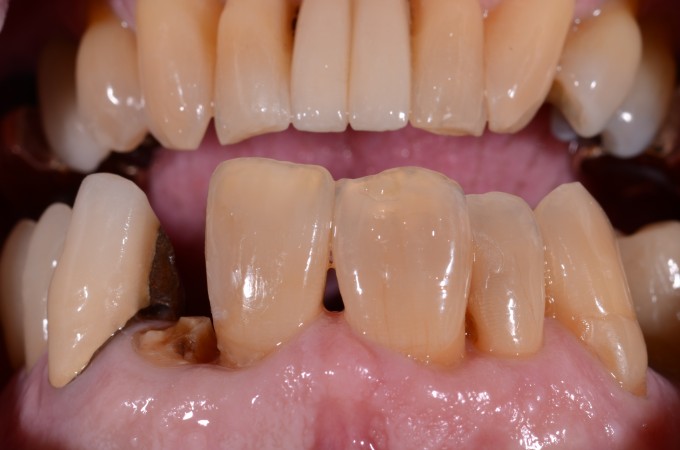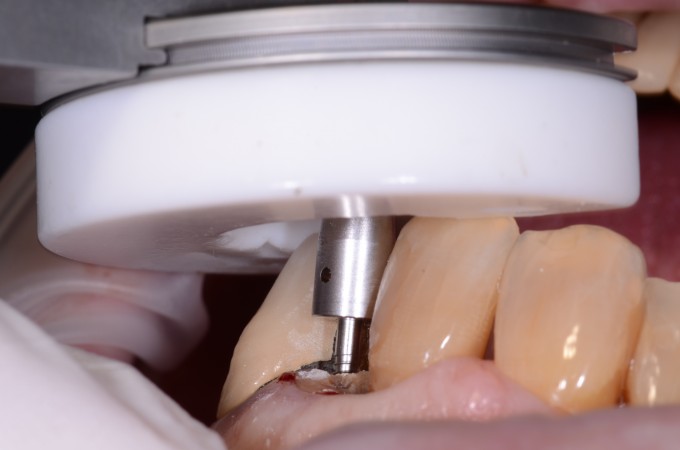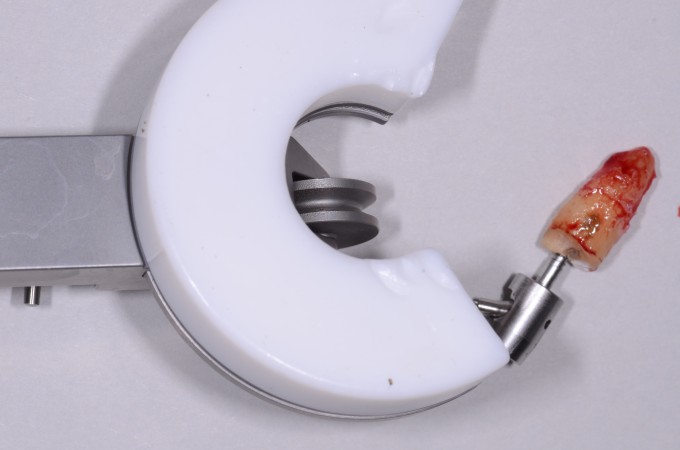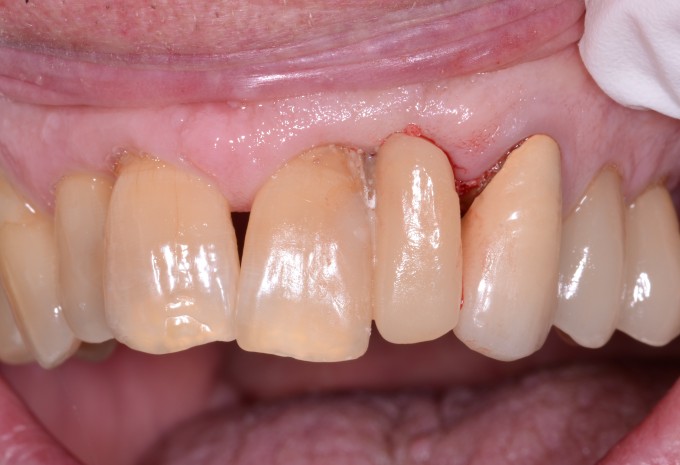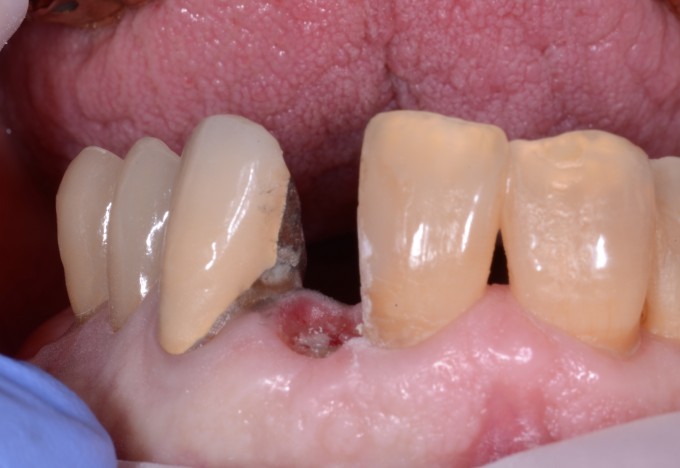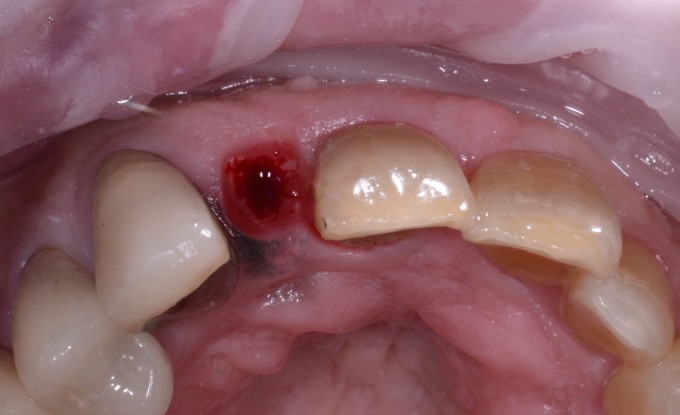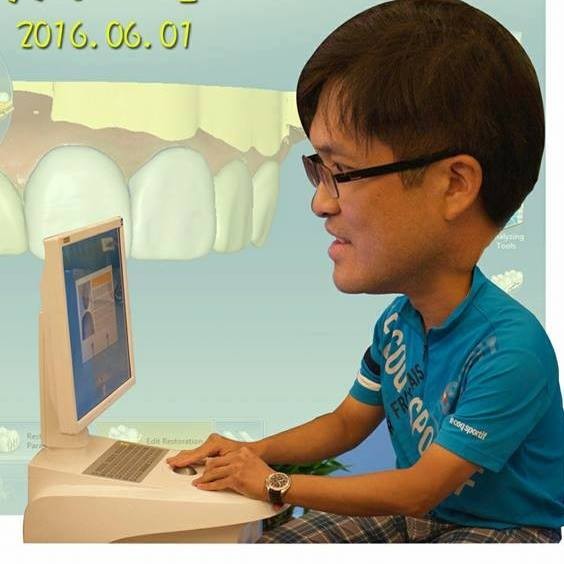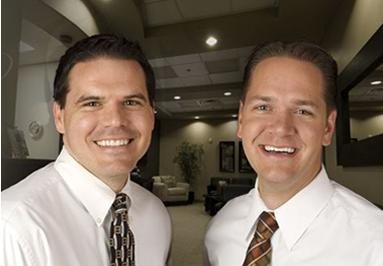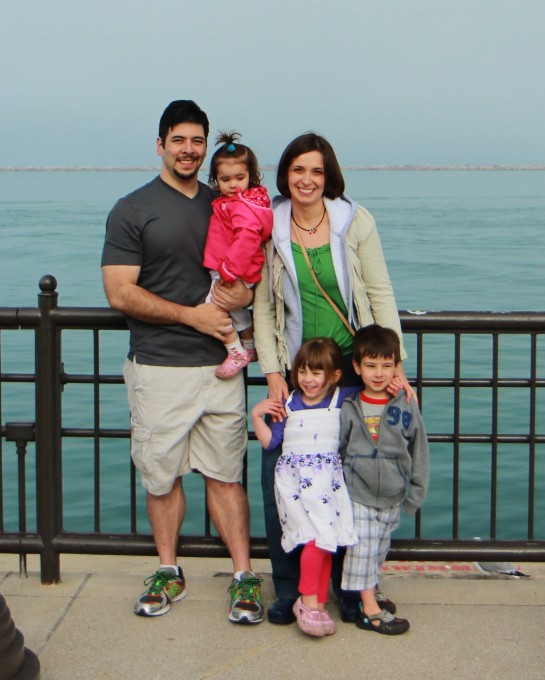Benex extractor and an Ovate Pontic: Management of a Fractured Lateral
This case is the classic example of when we get the call from a patient that their crown came off. That call can be anything from a quick recement to this
Needless to say there was not a lot that we could do with this case. So we talked about immediate extraction and implant. Now the trouble is of course getting the tooth out without causing damage to the buccal plate. For this I use the Benex Extractor system. The system allows you to extract the tooth atraumatically to preserve the buccal plate. First you drill down into the tooth. In this case there was not a root canal treatment to follow so I just bored into the root itself.
Once you have a guide path you then place in the engager. This gets screwed in by hand to the proper depth. There are various lengths and widths of engagers with cooresponding drills. The engager has a notch for a cable to be introduced. This cable is then attached to a wench type set up that has a pad for the teeth. The pad rests on the teeth to protect them from the pressue applied when turning the handle to remove the tooth.
The handle on the wench is turned to apply a steady upward force along the long axis of the tooth. The diagram below shows the whole apparatus being used.
The handle is turned and then you pause for a few seconds. This is repeated until you hear a pop and the tooth comes out.
After I got the tooth out I then placed the implant. It was a 3.3 straumann bone level implant. Now if we have a teliocad abutment and tibase we can make a temporary right away. Since these are not out right now we needed another options. Since I had clearance I went with a maryland bridge. This is also a good option when you have to graft or don't get good primary stability. When you do the maryland bridge place either a very short healing cap or in this case the implant was only 2-3mm below the gingival crest. So I placed a cover screw and then created an ovate pontic that almost touched it. There was about .5-.75 mm of distance from the bottom of the pontic to the cover screw.
By creating an ovate pontic I can start training the tissue right from the day of surgery. You can even measure the distance to the contacts to make sure you have 5mm. In this case the patient already has punched out papillae so getting a nice tall papillae probably won't happen. Here is the healed site after healing and integration.
Once we remove the maryland bridge a little bit of lasering is done with a diode to uncover the implant and we scan the area for either the permanent crown or a temporary to train the tissue more if better esthetics can be achieved. No in this case we profiled the bone after healing to get room for the tibase. 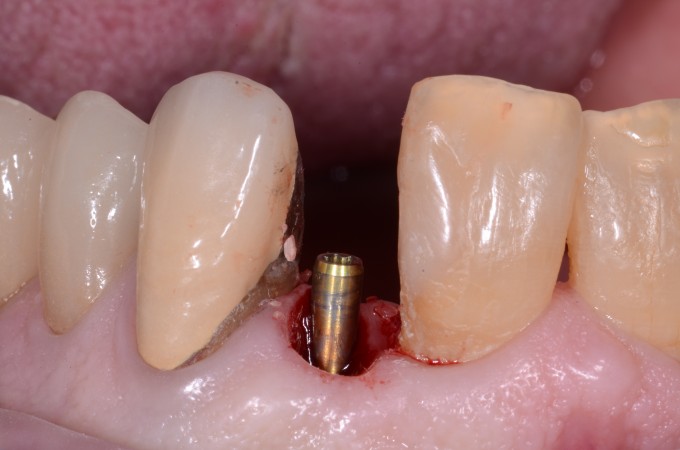
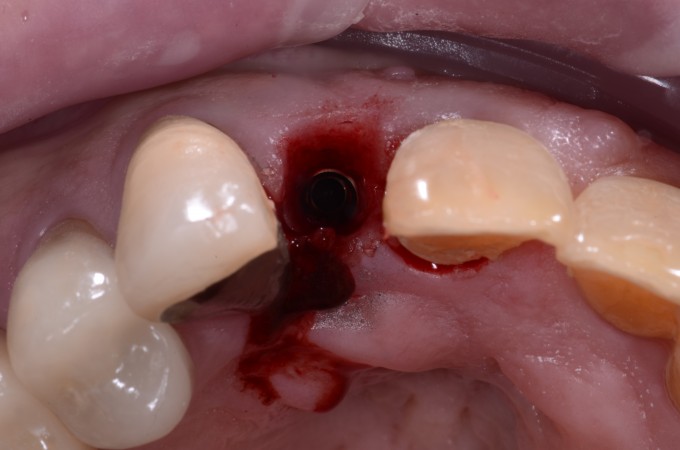
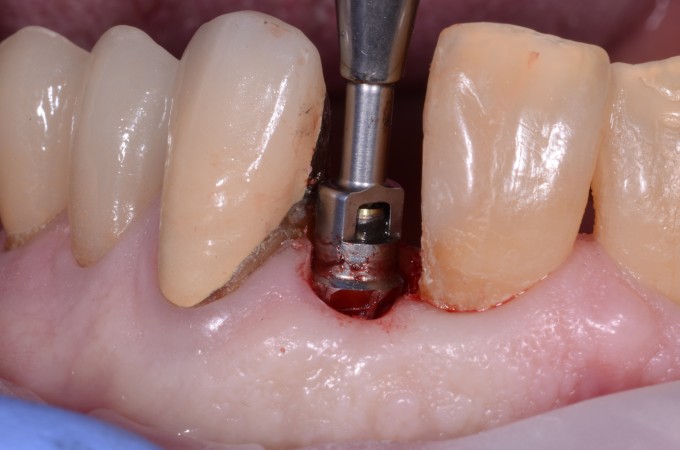
The area is now ready for restoring or training the tissue.
Great job Darin! I love the Benex too!
I think it's a good choice NOT to immediate provisionalize the 3.3. I have stopped doing this for the most part... too risky.
The only time I do is when there is plenty of room and I can profile enough to make it fit well.
Cool case Darin. That's the next thing I need to buy for my extractions. How long does it take to do an extraction like that using Benex?
Less than 10 minutes. It is so much easier than trying to finesse it out and not luxate the facial plate at all. It is worth every penny. I couldn't recommend it more.
I love this tool also,it does less trauma to the extraction site and preverse the buccal plate.
I'm using the Easy X-Trac as recommended here by Dr B in his Atraumatic Extraction series. It works most of the time except when the root is too beat up and has insufficient integrity for the extractor to grip. Other times I've unintentionally had the root split so the extractor couldn't grip. Dr Fernanda Haupshuldt of Brazil recommended a nice clinical pearl. She suggest using the 1 mm Luxator from JS Dental to mobilize the root slightly before applying the extractor. It has improved my success.
On 8/11/2015 at 3:41 pm, Louis Siegelman said... I'm using the Easy X-Trac as recommended here by Dr B in his Atraumatic Extraction series. It works most of the time except when the root is too beat up and has insufficient integrity for the extractor to grip. Other times I've unintentionally had the root split so the extractor couldn't grip. Dr Fernanda Haupshuldt of Brazil recommended a nice clinical pearl. She suggest using the 1 mm Luxator from JS Dental to mobilize the root slightly before applying the extractor. It has improved my success.
I go down the root surface with a periotome to help loosen the fibers. The other key is turn the handle and let it sit for a few seconds then turn some more and let it sit. The easy extract you push down and it is all or nothing. That is one thing I like about the Benex by doing quarter and half turns and waiting it doesn't strip out of the root as much. If I think it is really going to be a tough one then I will gently luxate in a mesial and distal direction with no movement facially.
Yeah. Its not a cheap system. But I use it all the time for atramatic extractions. Perfect for implant placement... Sometime too perfect and I dont get a lot of bleeding and I'll go in there and make the socket bleed with a bone file in areas the implant drill would not touch.
On 8/11/2015 at 3:52 pm, Darin O'Bryan (Faculty) said...On 8/11/2015 at 3:41 pm, Louis Siegelman said... I'm using the Easy X-Trac as recommended here by Dr B in his Atraumatic Extraction series. It works most of the time except when the root is too beat up and has insufficient integrity for the extractor to grip. Other times I've unintentionally had the root split so the extractor couldn't grip. Dr Fernanda Haupshuldt of Brazil recommended a nice clinical pearl. She suggest using the 1 mm Luxator from JS Dental to mobilize the root slightly before applying the extractor. It has improved my success.I go down the root surface with a periotome to help loosen the fibers. The other key is turn the handle and let it sit for a few seconds then turn some more and let it sit. The easy extract you push down and it is all or nothing. That is one thing I like about the Benex by doing quarter and half turns and waiting it doesn't strip out of the root as much. If I think it is really going to be a tough one then I will gently luxate in a mesial and distal direction with no movement facially.
Darin,
Nice case and great documentation. It's worth to point out to others that you used a drill extender with the Straumann bone profilers. IMO the bone profilers are too short for a lot of cases and one must therefore oftentimes use a drill extender (which Straumann does not sell BTW as far as I know).
I don't quite know what you mean by "pushing down" with the Easy X-Trac? I use the same technique with the Easy X-Trac as well....Turn alittle and then wait to let the tension forces take effect. I have both systems and I personally have been more successful with the Easy-X-Trac system due to their screws being longer. However, Benex recently improved their screws by adding longer screws and I have not tried those yet.
BTW: There is a little known software tool known as "flip vertical"![]() ...lol.
...lol.
Farhad
How thick was the labial plate and did you place any graft material to fill the labial void - assuming you took a slightly palatal placement.
I am interested in this as my Benex is waiting for its first patient !
Great result .
On 8/11/2015 at 9:57 pm, Farhad Boltchi (Faculty) said...On 8/11/2015 at 3:52 pm, Darin O'Bryan (Faculty) said...On 8/11/2015 at 3:41 pm, Louis Siegelman said... I'm using the Easy X-Trac as recommended here by Dr B in his Atraumatic Extraction series. It works most of the time except when the root is too beat up and has insufficient integrity for the extractor to grip. Other times I've unintentionally had the root split so the extractor couldn't grip. Dr Fernanda Haupshuldt of Brazil recommended a nice clinical pearl. She suggest using the 1 mm Luxator from JS Dental to mobilize the root slightly before applying the extractor. It has improved my success.I go down the root surface with a periotome to help loosen the fibers. The other key is turn the handle and let it sit for a few seconds then turn some more and let it sit. The easy extract you push down and it is all or nothing. That is one thing I like about the Benex by doing quarter and half turns and waiting it doesn't strip out of the root as much. If I think it is really going to be a tough one then I will gently luxate in a mesial and distal direction with no movement facially.
Darin,
Nice case and great documentation. It's worth to point out to others that you used a drill extender with the Straumann bone profilers. IMO the bone profilers are too short for a lot of cases and one must therefore oftentimes use a drill extender (which Straumann does not sell BTW as far as I know).
I don't quite know what you mean by "pushing down" with the Easy X-Trac? I use the same technique with the Easy X-Trac as well....Turn alittle and then wait to let the tension forces take effect. I have both systems and I personally have been more successful with the Easy-X-Trac system due to their screws being longer. However, Benex recently improved their screws by adding longer screws and I have not tried those yet.
BTW: There is a little known software tool known as "flip vertical"
...lol.
Farhad
In most cases you will need a drill extension on the profiles, especially in the anterior.
I may have mistaken the easy Xtrac for a different system. There is one out there that has a lever system thats the one I thought was the Easy X-trac.
I am aware of the flip veritcal. I was trying to give the clinicians POV to give a the real perspective ![]() That's my story and I am sticking to it.
That's my story and I am sticking to it.
On 8/12/2015 at 6:29 am, Clive Dickinson said...How thick was the labial plate and did you place any graft material to fill the labial void - assuming you took a slightly palatal placement.
I am interested in this as my Benex is waiting for its first patient !
Great result .
The plate was pretty thin. I will try and post a clip from the CT later this morning. I always graft the gap, buccal/facial or lingual, in any immediate case. I just sleep better at night knowing I did everything I could to prevent crestal bone loss.
I love the Benex. In fact, I love it and their customer service. If you have questions about it, get a hold of Matthew Miller at Meisinger (mmiller@meisingerusa.com). I will also agree that a little periotome and M-D luxation is a good idea first unless the tooth has granulation tissue around it. I have broken two of the traction cables in the last two weeks removing teeth on large men. If I had gotten a little luxation first, I likely wouldn't have had this problem. I contacted Meisinger and they got me replacements very quickly.
On 8/11/2015 at 9:57 pm, Farhad Boltchi (Faculty) said...On 8/11/2015 at 3:52 pm, Darin O'Bryan (Faculty) said...On 8/11/2015 at 3:41 pm, Louis Siegelman said... I'm using the Easy X-Trac as recommended here by Dr B in his Atraumatic Extraction series. It works most of the time except when the root is too beat up and has insufficient integrity for the extractor to grip. Other times I've unintentionally had the root split so the extractor couldn't grip. Dr Fernanda Haupshuldt of Brazil recommended a nice clinical pearl. She suggest using the 1 mm Luxator from JS Dental to mobilize the root slightly before applying the extractor. It has improved my success.I go down the root surface with a periotome to help loosen the fibers. The other key is turn the handle and let it sit for a few seconds then turn some more and let it sit. The easy extract you push down and it is all or nothing. That is one thing I like about the Benex by doing quarter and half turns and waiting it doesn't strip out of the root as much. If I think it is really going to be a tough one then I will gently luxate in a mesial and distal direction with no movement facially.
Darin,
Nice case and great documentation. It's worth to point out to others that you used a drill extender with the Straumann bone profilers. IMO the bone profilers are too short for a lot of cases and one must therefore oftentimes use a drill extender (which Straumann does not sell BTW as far as I know).
I don't quite know what you mean by "pushing down" with the Easy X-Trac? I use the same technique with the Easy X-Trac as well....Turn alittle and then wait to let the tension forces take effect. I have both systems and I personally have been more successful with the Easy-X-Trac system due to their screws being longer. However, Benex recently improved their screws by adding longer screws and I have not tried those yet.
BTW: There is a little known software tool known as "flip vertical"
...lol.
Farhad
I'm with Farhad, I have both systems but have had better success over the years with Easy X-Trac. I also just use slow, quarter turns to slowly loosen tooth. With Easy X-Trac, I would like a larger assortment of screw heights and larger diameter screws for those teeth with gross caries down a previously RC tooth.
Great case Darin and nice documentation, thanks for sharing.


